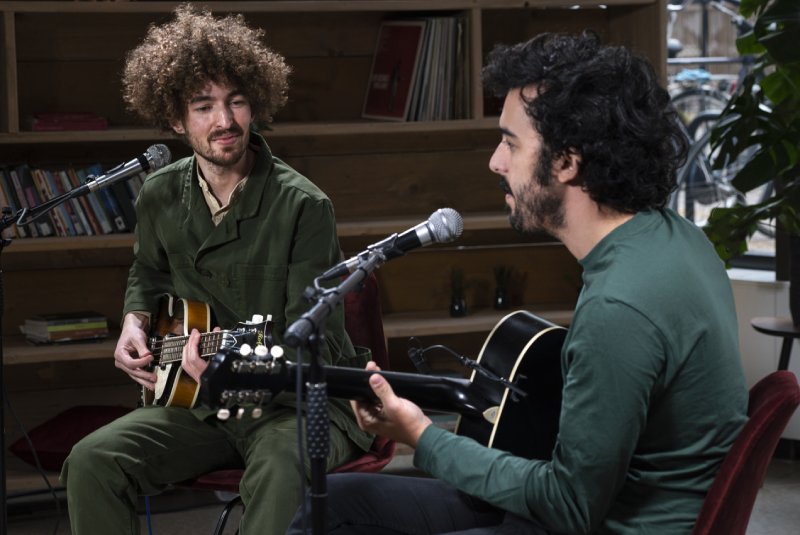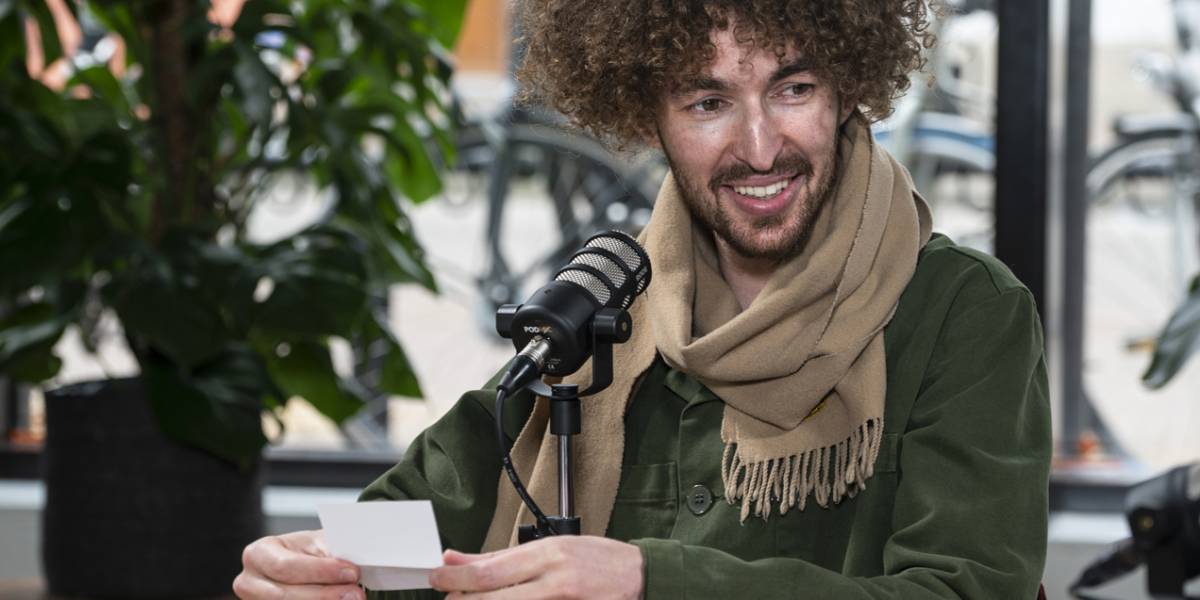Breno Virícimo: connector from Brazil
Text: Ton Maas
Bass player and bandleader Breno Virícimo, who in 2021 as part of Music Meeting Concerts performed with his project Cantorias, was born in Santa Catarina, a state in southern Brazil, just above Rio Grande del Sul: the region where gauchos drink their maté and accordions set the tone.
It was on the radio that young Breno heard local styles such as the centanejo, heavily influenced by European traditions, just like the chamamé from the neighbouring Missiones in the north-east of Argentina. That was very different to the music normally associated with Brazil, such as the bossa nova and samba.
At home he also heard other types of music because his father Virícimo, who is a percussionist, was particularly interested in the styles from the north-east of Brazil, such as baião and forró. Another favourite was Gilberto Gil. Breno: ‘Just like salsa, though you perhaps might not expect that from a Brazilian. Oddly enough, I only got to know samba when I went to study music in São Paulo, just like the samba-jazz of João Gilberto and others.’
Father Virícimo impressed upon his son that – if you want to take music seriously – you have to follow a study and continue to develop. For Breno, that meant saying farewell to the small provincial town where the family lived and moving to São Paulo to study at the conservatory. And there he learned about further opportunities to study abroad.

Crossing boundaries
The US attracted his interest initially, if only because of the fantastic jazz musicians. But that would be an expensive undertaking for a Brazilian from the province. Moreover, to him Europe seemed culturally more varied and interesting. You move quickly from country to country, each with its own language, culture and cuisine. Furthermore, Breno’s father had taught him that his instrument, the double bass, originated in Europe as part of the orchestra tradition, and that was why you could best head for Europe to develop further.
So Europe it was. First stop Belgium, where Breno spent a year studying at the conservatory in Antwerp. But in the end he relocated to Amsterdam, not only because of the reputation of the Sweelinck but also because of the much bigger Brazilian community in the Netherlands. Completely in line with the joke that most bass players are in fact failed guitarists, the double bass was not the first instrument for Breno. That was classical guitar. He played his first bossa-nova song on that as a child.
The bass appeared in his life when Virícimo senior purchased an acoustic bass guitar, with the intention of learning to play it himself. But things turned out differently: his dear son was the one to take on the instrument. After that, father and son had a band together for a time. The step from bass guitar to double bass came later, during Breno’s studies in São Paulo, when he dived deeper into jazz.
The switch from guitar to bass occurred smoothly, thanks to that acoustic bass guitar. That’s a convenient instrument, and the new YouTube medium enabled Breno to learn from the world’s greats to his heart’s content, simply by playing along. But it was mostly by playing in bands that he could develop into a genuine bass player. In his view it was the bass that encouraged him to become a real musician, while the guitar always remained something for ‘between the sliding doors’. That was the division of roles for a long time. Breno: ‘At home I liked to play about with the guitar, but as soon as I played with others, I picked up the bass.’
The guitar came back into the frame again when he arrived in the Netherlands. Breno: ‘That actually happened thanks to a performance with Laura Polence, for which we hadn’t prepared enough numbers. So we spontaneously played a couple of Brazilian tunes that she knew and that I’d once tried out back at home in Brazil, so that I could accompany her on guitar. That went down so well that we performed together as a duo for a while.’ And that’s how the guitar finally found its place on stage.
De birth of Olaiá
Since arriving in the Netherlands about a decade ago, Breno has often played with other Brazilian musicians and with Dutch musicians who are crazy about Brazilian music. That gave him the idea to create a place for all those musical exchanges. It took the form of weekly sessions, always on Saturdays, that were recorded on video and then posted online. And thus Olaiá was born. Initially it involved a group of friends. Singer Femke Smit was part of it straight away. Her friend Laura Polence soon joined, followed by more and more people with a connection to Brazilian music.
For the first six months Breno did almost everything alone. Then someone took over the camerawork from him, which had a favourable effect on the quality of the videos. At the start the sessions always involved a duet, but gradually there was a desire for larger formations. Around the same time they received an invitation from Studio 150 in Amsterdam to provide a live-stream. For that, Breno decided to invite Femke, Lilian Vieira and Anna Serierse: ‘The idea to perform two of the numbers with polyphonic sound turned out so well that we decided to continue down that road.’ And that led to Cantorias. Then it was obvious to bring Nina Rompa on board, because she’d been working for much longer with Anna. When they’d developed enough of a repertoire for a complete performance, Breno decided to add another two musicians on drums and guitar. The combination with himself on bass proved very effective and, moreover, everybody was enthusiastic.
Songs being sung
So Cantorias actually emerged as a separate project from Olaiá. As for the name: ‘We more or less made that up. In Latin, ‘cantus’ means singing, and ‘cantorias’ sounds a bit like the female form of it. What we mean by it is something along the lines of “songs that are sung”, analogous to stories that are told. Cantorias is an existing word in Portuguese, but it’s not used very often.’

There’s definitely a nostalgic touch to the refined sounds in the close harmonies of Cantorias, something you seldom hear today. According to Breno, that impression is enhanced by its jazzy character, which reminds the listener involuntarily of the heyday of the Andrews Sisters. But Brazil has also had its shining examples of vocal groups such as Cuarteto and Cy, which were extremely popular, especially in the 1960s and 1970s, and formed a source of inspiration for Cantorias.
The women were immediately enthusiastic about taking on the challenge. Breno: ‘But it then took a lot of time and effort before their voices really blended together.’ The corona restrictions made that process even more difficult. Rehearsals were frequently cancelled because somebody wasn’t feeling well or had been in close contact with someone else who tested positive. Breno: ‘What’s more, we always had to keep our distance, while for close harmony you actually prefer to stand close to one another. Luckily, we were able to get around that particular restriction by working as much as possible with microphone and headphones.’
Despite all those restrictions, the project proved to be something of a life line for many of those involved during this difficult period. Breno: ‘After one successful rehearsal, Femke told me that it had saved her month. Apart from the lost income, it’s vitally important for many musicians to be able to play together. For many of them, making music is definitely the most important thing in their lives. All aspects of it – social contacts, work, income – everything is connected to music. So those five hours spent together making a video in the studio can be enough to ensure that you have a good week.’
Dreams for the future
Another project that Breno came up with for Olaiá Sessions was to let local musicians work together with a Brazilian artist in residence, who is specially invited for the occasion. ‘We bring over the musician for two weeks, so that they can work together and rehearse for about ten days before we record four pieces.’ In July this year we launched this new project, with as first guest the Brazilian singer Leo Middea, who lives in Lisbon. Breno: ‘It’s fantastic that we managed to secure the funds need to make it happen. We were able to spend two weeks in the studio, writing and recording the pieces. That was amazing! Moreover, it means that from now on we have more and more original material at our disposal. Who knows, maybe it might lead to the founding of a small, independent label for Brazilian music.



